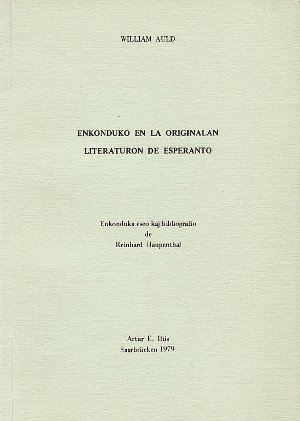AULD, William: Enkonduko en la originalan literaturon de Esperanto. Artur E Iltis, 1979. 101 p.
AULD, William: Vereco, distro, stilo: romanoj en Esperanto. Artur E Iltis, 1981. 101 p.
BENCZIK, Vilmos: Studoj pri la Esperanta literaturo. La Kritikanto, 1980. 144 p.
BENCZIK, Vilmos: Libro de romanoj. Hungara Esperanto-Asocio, 1979. 229 p.
Some "authorities" on language are quick to pontificate, ex cathedra, to the effect that Esperanto must be of no interest because it has neither history nor literature. The history of Esperanto is a rather fascinating subject, but I won't discuss it here. The literature of Esperanto is such a complex topic that, by the late twentieth century, we find, in addition to the literature itself, a whole plethora of books written about that literature. The four listed above are recent examples.
Benczik's Studoj is, as the title says, a collection of essays and studies about various aspects of Esperanto's literature, taken from various sources over the past decade or so. Four of these fourteen essays cover general topics; the other ten discuss the importance of various individuals involved in the production of the literature, from Henri Vallienne (who wrote the first two original novels in Esperanto) to Victor Sadler (author of Memkritiko, a critically acclaimed book of poetry, who was then sidetracked into the administrative side of the Esperanto movement and never produced another book ...).
Auld's Enkonduko covers much of the same territory, but in a different way. Auld's book is less meaty than Benczik's, but it is much more unified, since it was originally prepared as a series of lectures to be given to a single audience in Germany in 1977. In 1981 it remains the best overview of Esperanto literature yet published; but I should add that the definitive work on the subject is yet to be written.
Another German weekend -- this one in May, 1980 -- gave us Auld's Vereco, distro, stilo. Like Enkonduko, this is a rather short overview, but has the advantage of presenting a unified view of its topic -- the original novel in Esperanto. Auld covers the field fairly thoroughly, from Vallienne to Valano, but even he has been outdistanced by events; he does not mention Piĉ's recent La litomiŝla tombejo (although the publisher, who is also the publisher of the Piĉ novel, slips it into the bibliography); and we read nothing of Eva Tofalvi and Oldrich Knichal, who won the Raymond Schwartz prize for Best Novel in Esperanto for Kiuj semas plorante -- which is only reasonable, since the award was not given until after Auld's Saarbrüken weekend. All in all, I should say that, as good as it is, this book is proof that in Esperanto literature it is impossible for the critic to keep up with the events.
Benczik's Libro de romanoj is an almost indispensable companion work for Vereco, distro, stilo. This book consists entirely of condensations of two novels by Henri Vallienne and four novels by H. A. Luyken, two of Esperanto's earliest novelists. For those who believe with me that it is always better to read the originals than mere condensations, I add this cautionary note. Only one of the six works (Luyken's Pro Iŝtar) is still available. None of the six, for various reasons, is likely to be reprinted in the near future; (1) their importance is not intrinsic, but simply due to their part in the development of Esperanto literature. If you are interested in this facet of Esperanto, you should know about these novels; and this book is the way to find out about them.









